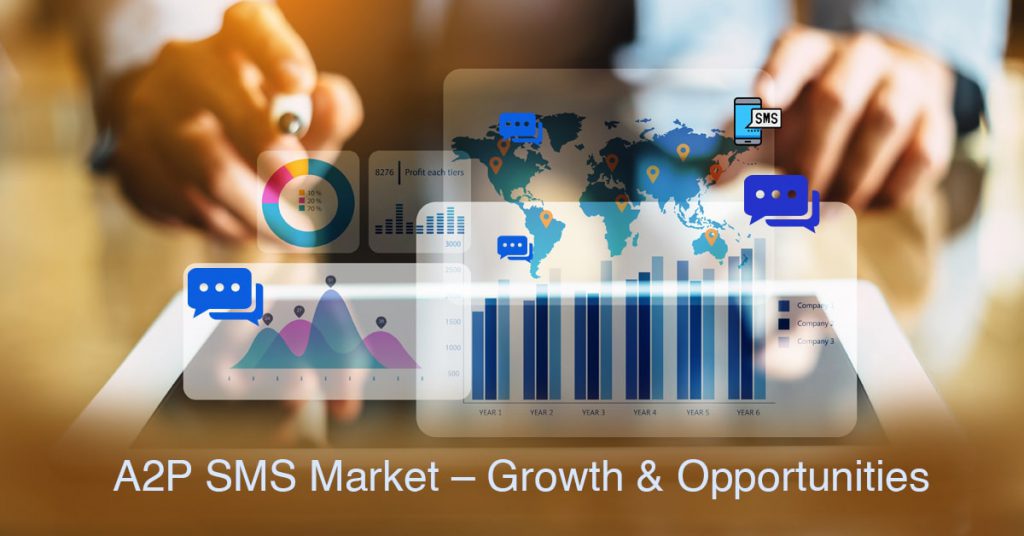
Chat apps and social media messaging may dominate today’s conversations, but there’s a common misconception that SMS is outdated or irrelevant. In today’s digital-first world, we still rely heavily on those simple, automated texts in the form of banking transactions, OTPs, appointment reminders, and whatnot. These texts are known as A2P SMS – a massive, multi-billion dollar business that’s been booming quietly.
Driven by mobile penetration and digital transformation, A2P, or Application-to-Person SMS, remains one of the most reliable, universally supported, and high-reach messaging channels available.
Let’s explore what’s happening in this market – the size of the A2P SMS market, its growth drivers and challenges, comparison with RCS, and steps that aggregators can take to leverage this evolving space.
What is A2P SMS and Why does it Matter for Businesses
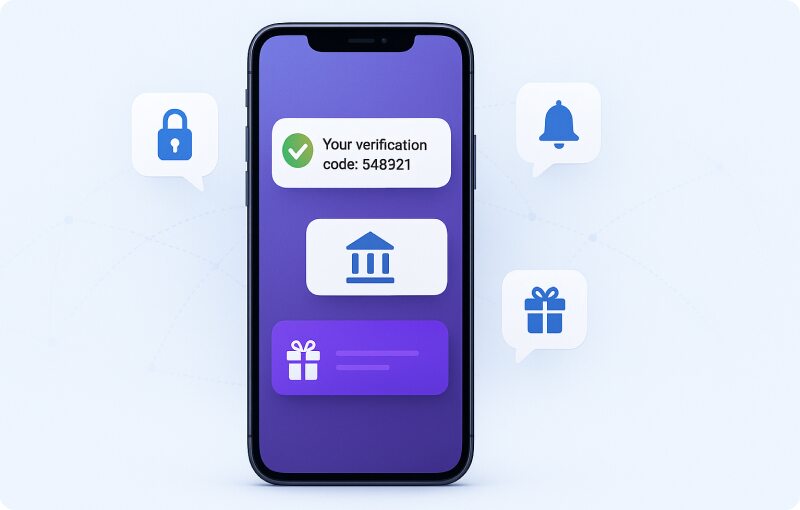
A2P SMS messages are sent from software applications to individual users, like customers. A2P is different from P2P or Person-to-Person messaging because A2P messaging is automated, bulk, or triggered by an event. Some simple use cases of A2P SMS include OTP, transaction alerts, appointment reminders, system alerts, etc.
For businesses, A2P brings ample reasons to be the preferred choice for communication. This includes high deliverability, near-universal reach, and high open rates.
Global A2P SMS Market Size Overview
According to Grand View Research, the global A2P messaging market was valued at around USD 71.50 billion in 2024 and is projected to reach about USD 96.73 billion by 2030, with a CAGR of ~5.4% from 2025 to 2030. A more specific estimate for A2P SMS suggests that in 2024 it was valued near USD 78.18 billion, with forecasts reaching USD 109 billion by 2034 (CAGR ~3.2%). Source
These varying estimates reflect a very clear trend: the market is experiencing steady, long-term growth. This growth is largely fueled by enterprise adoption, as businesses across banking, retail, healthcare, and logistics increasingly rely on A2P SMS for authentication (OTP), alerts, marketing, and customer engagement.
Even with emerging channels like RCS and OTT messaging, A2P SMS continues to expand its footprint, proving its resilience as a trusted, universal, and regulation-friendly communication medium.
Regional Insights: Where the Growth Lies
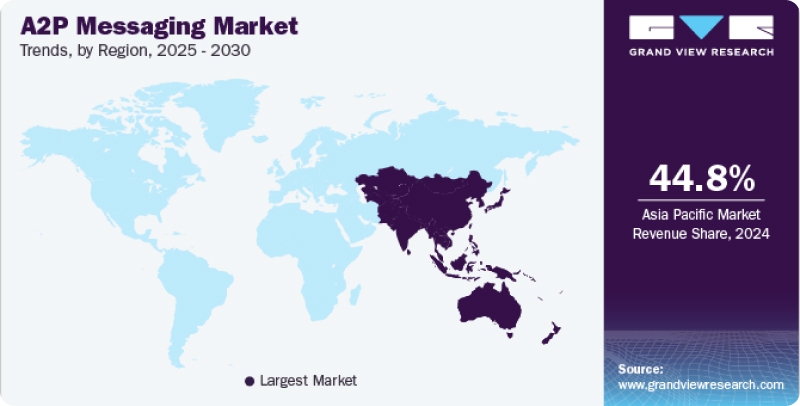
The A2P SMS market can be segmented based on geographical regions such as North America, Europe, Asia Pacific, the Middle East and Africa, and Latin America.
- North America continues to be one of the leading regions in the A2P messaging landscape. With exceptionally high smartphone penetration, consumers across the U.S. and Canada are easily reachable through mobile messaging.
- In the United States, advanced digital infrastructure and continuous innovation have positioned the country at the forefront of A2P messaging adoption. Industries such as finance, healthcare, and retail rely heavily on SMS for transaction alerts, reminders, and real-time notifications, cementing the U.S. as the dominant market in North America.
- Europe is emerging as a lucrative region for A2P messaging, fueled by its cultural diversity and multilingual landscape. Businesses are increasingly using personalized and localized SMS campaigns to engage customers across borders. Moreover, the rise of IoT and smart technologies has opened new A2P applications – from device alerts to remote monitoring. The U.K., in particular, is witnessing rapid growth driven by mobile marketing adoption and data privacy laws like PECR, which reinforce consumer trust in business messaging.
- Meanwhile, Asia Pacific commands the largest global market share, driven by its booming e-commerce ecosystem and rapid digitalization. A2P messaging supports everything from order confirmations to delivery updates and customer engagement across major markets like China, India, and Japan.
A2P SMS Industry Growth Drivers

1. Increasing Adoption of Mobile Phones and Smartphones
The global smartphone adoption rate has been steadily increasing over the years. In 2025, there are an estimated 7.3 billion smartphones in active use worldwide. This near-universal connectivity means that almost every consumer can instantly receive text notifications, OTPs, and service alerts, regardless of their internet access or device type. As more people use mobile devices to access the internet and communicate with others, the demand for A2P SMS will only climb higher.
With the continuous increase in the mobile subscriber base, it becomes easy for MNOs, enterprises, and application developers to connect with their users. Making more investments in A2P services, MNOs target to increase their revenue, which has been coming down due to various reasons, including the growth of OTT.
2. Expeditious Development of E-commerce & M-commerce
Online shopping and mobile transactions are common things nowadays. There’s no doubt about the fact that the majority of businesses rely on A2P messages to communicate with customers. Some common examples include sending notifications and conveying critical information to customers.
3. More Demand for Mobile Banking and Financial Services
The usage of A2P SMS is quite significant in the banking and finance industry. A few examples include one-time passwords and transaction alerts. Also, the demand for mobile banking and financial services is on a continuous rise, which means that the A2P SMS market is surely going to grow by leaps and bounds.
4. IoT & Machine Communication
Another interesting growth vector is the rise of IoT (Internet of Things) and machine-to-machine (M2M) communication. Connected devices, from industrial sensors to smart meters, frequently use SMS to send status updates, fault alerts, or location data in environments where IP connectivity isn’t always available. This machine-level usage contributes a steady and often underappreciated volume to global A2P traffic.
5. Growth of CPaaS
The industry has also benefited from the rapid growth of CPaaS (Communications Platform as a Service) solutions. Modern CPaaS providers offer powerful APIs that make it easy for enterprises to integrate SMS into their apps, websites, and business workflows. Developers can now automate notifications, marketing messages, and verification codes with just a few lines of code, bringing enterprise messaging to a much wider audience.
6. Globalization
Globalization is amplifying the demand for A2P. As businesses expand across borders, they need a channel that can reach customers anywhere in the world with consistent quality. This has led to a surge in cross-border messaging, driving growth for SMS aggregators, international gateways, and routing platforms that ensure smooth, high-quality delivery at scale.
A2P SMS vs. RCS: The Future of Mobile Messaging
Both A2P SMS and RCS have their strengths – the former continues to dominate business communications globally, the latter has emerged as the next-generation contender, promising interactive and media-rich engagement. A crucial point to consider is the usage and suitability of each in the evolving business communication landscape.
Let’s compare:
1. Reach
A2P SMS works on virtually every mobile device, across all networks, without requiring internet connectivity or app installations. It’s universal, reliable, and immediate. RCS, on the other hand, requires device and operator compatibility and active data connectivity.
2. Interactivity
A2P SMS is evolving through the use of SMS URLs, short links, and API-triggered interactions. However, its multimedia capabilities are still limited. RCS supports high-resolution images, carousels, suggested replies, location sharing, and even in-message payments. This makes it ideal for rich customer experiences such as product demos, appointment scheduling, and guided shopping flows.
3. Scalability and Affordability
A2P SMS is far more cost-efficient at scale, especially for high-volume transactional or promotional messaging. RCS involves more complex cost structures due to additional costs for branding, verification, and content management.
4. Enterprise Adoption
A2P SMS is the trusted channel adopted across banking, retail, logistics, and healthcare due to its universal delivery and regulatory compliance. RCS is still in its early enterprise adoption phase. Brands are experimenting with RCS Business Messaging (RBM) for marketing campaigns and customer engagement, but fragmentation across devices and operators remains a challenge.
Challenges Shaping the A2P SMS Ecosystem
While the remarkable growth and universal reach of A2P SMS are undeniable, the ecosystem is currently being tested by a new set of challenges.
1. Technical Anomalies Overriding Bulk SMS
Often, SMS is linked with basic phone features, so mobile brand companies often ignore it while developing smartphone features. The true potential of messaging technology as a marketing tool has not yet been tapped by Bulk SMS service providers.
The main reason for that brand owners and marketers are quite enthusiastic about the features and experiences they can offer through mobile web and apps, which often outshine the features offered by A2P messaging.
However, there are different types of challenges, such as leveraging SMS, that can fit a broad mobile strategy. Experts are needed to set up an SMS program so that permissions are structured easily from wireless carriers. For the growth of the A2P SMS market, generating shortcodes used in SMS campaigns is another challenge.
As A2P SMS mostly relies on the usage of shared or dedicated shortcodes, brand promoters often get confused and bear the uncertainty while setting up shortcodes and regulations.
2. Security Concerns
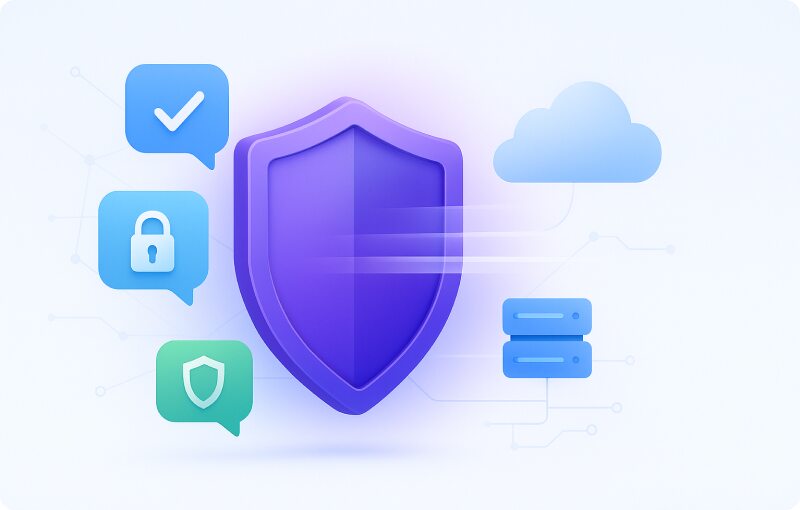
A2P SMS is vulnerable to various security threats, including phishing attacks, SMS spoofing, and malware. According to the Federal Trade Commission (FTC), losses from scam texts grew to $470 million, which is more than five times the amount recorded in 2020. Businesses need to ensure that their A2P SMS services are secure and compliant with data privacy regulations. As enterprises are using SMS messaging services to improve user experience by communicating with them, the immediate need to protect the data of their organizations and customers has emerged as one of their top priorities.
3. Competition from Other Messaging Platforms
With the growing popularity of messaging apps such as WhatsApp, WeChat, and Facebook Messenger, businesses may shift their focus away from A2P SMS. Several key factors are driving this transition: the rich media and interactive capabilities of OTT apps, the cost advantages they offer in specific markets, the emergence of RCS, and changing customer preferences.
4. Increasing Regulations
Governments around the world are implementing new regulations to protect consumers from spam and fraudulent messages. These regulations may impact the A2P SMS market by limiting the number of messages that businesses can send to customers.
Despite these challenges, the A2P SMS ecosystem will not disappear, as its fundamental strengths, including universal reach, instant delivery, and unparalleled reliability for critical messages like OTPs and alerts, remain unmatched. The task ahead is to fortify these core strengths against the challenges while strategically integrating next-generation capabilities.
The Future Outlook of A2P SMS Messaging
What does the future hold for Application-to-Person (A2P) SMS messaging? Here are some powerful new capabilities that will redefine the A2P landscape, create new revenue streams, and force a strategic shift for enterprises and operators alike.
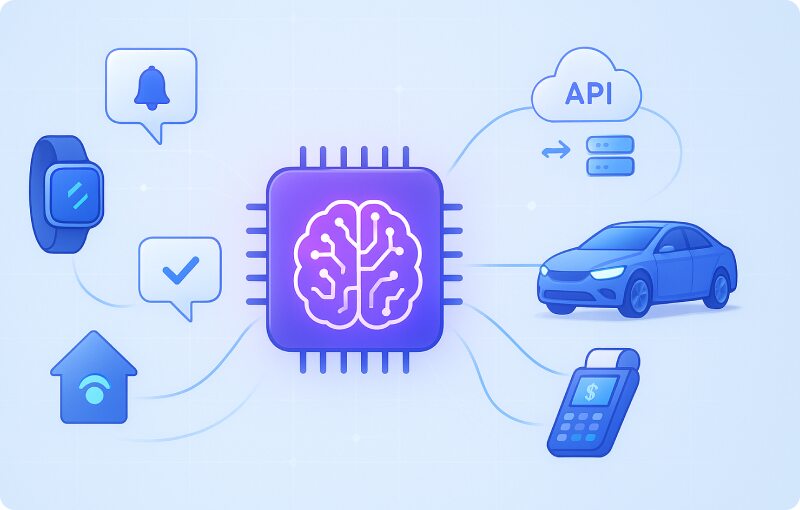
1. Use of Artificial Intelligence (AI)
AI, or Artificial Intelligence, is a popular concept these days, which is gaining more and more momentum. The A2P SMS industry is not left untouched as businesses are using AI-powered chatbots to connect with customers and cater to their needs. AI technology is also helpful in analyzing A2P messaging data for improved performance and better customer engagement.
2. Increasing Adoption of RCS
Businesses want to deliver a rich messaging experience to their customers in the form of multimedia content. This is where RCS or Rich Communication Services comes into action. This technology is gaining momentum in the A2P SMS market because it helps businesses in delivering personalized experiences to their clients.
3. More Focus on Privacy & Protection of Customer Data
Data privacy and protection are primary concerns for every business these days. This is why the implementation of relevant measures for the protection of customer data and ensuring compliance with the regulations is increasing. Data encryption and compliance with GDPR are the two most common measures being implemented.
4. Shift to Omnichannel Messaging
Omnichannel messaging, which means using multiple channels to connect with existing and potential customers, is a popular trend adopted by businesses across the globe. Some common examples of different channels include SMS, social media, chatbots, IM platforms, etc. It provides businesses with the opportunity to reach their audience across different touchpoints. This shift helps businesses to provide a smooth and unified messaging experience to customers.
In essence, the future of A2P SMS is not about competition with emerging channels – it’s about coexistence and integration. As part of a broader, intelligent communication strategy, A2P SMS will remain the foundation of trusted, high-delivery messaging in an increasingly interconnected, AI-driven world. Businesses that stay up-to-date with these trends and adopt innovative messaging strategies are well-positioned to succeed in this dynamic and evolving market.
How Resellers and Aggregators Can Tap Into the Growth
As enterprise demand for secure and reliable A2P messaging surges, Aggregators, MNOs, and MVNOs have a unique opportunity to move beyond traffic reselling and become full-fledged business messaging providers. By deploying a carrier-grade SMS platform like REVE SMS, they can launch or expand enterprise-grade A2P messaging services.
With built-in anti-fraud controls, real-time billing, and intelligent routing, CSPs can enhance reliability, ensure compliance, and tap into new revenue streams, transforming from connectivity providers into value-driven messaging partners for enterprises worldwide.
Final Thoughts: The Evolving Mobile Messaging Market
The mobile messaging market is evolving, but A2P SMS remains a trusted, ubiquitous, and revenue-generating foundation. For CSPs, aggregators, and communication platform providers, the goal is to become an indispensable partner to enterprises, enabling them to reach users globally, reliably, and with rich content. Our experts are ready to guide you in the best possible way – avail a free consultation today!
FAQs: A2P SMS Market Size
What is the difference between A2P SMS and RCS messaging?
A2P SMS works on nearly all devices and networks; RCS allows richer, interactive messaging, but requires RCS support on the device and carrier side.
Can A2P SMS be personalized?
Yes, A2P messages can be templated and personalized via variables such as name, account number, etc., for better engagement.
What is SMPP in A2P SMS?
SMPP (Short Message Peer-to-Peer) is a protocol used by SMS gateways to exchange messages with carriers.
How do regulations affect A2P SMS?
Many countries regulate sender identification, opt-in/opt-out, message content, and number registration to control spam messages.
What types of enterprises use A2P SMS the most?
Banks/financial services, e-commerce, healthcare, logistics, travel, government, and telecom companies heavily rely on A2P for communicating with their customers.






















